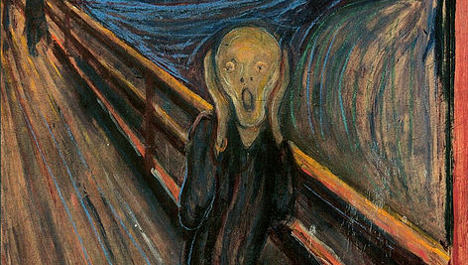"The Scream", of course, is there. So too are other treasures, including "Madonna", "Vampire" and "The Dance of Life."
Open to the public from Sunday, the "Munch 150" exhibition offers an unprecedented look into his long artistic career, from his earliest works until his death in 1944.
"There have been many exhibitions on Munch in the past but for artistic or practical reasons, they generally focused on just one theme," Audun Eckhoff, director of the National Gallery in Oslo, told AFP.
This time the exhibition is designed to show the evolution and scope of work of the great artist through 270 paintings and drawings.
The organisers are using two different venues.
The National Gallery deals with "how Munch became Munch," Eckhoff explains. It zooms in on the formative period from 1882 to 1903.
The second venue, the Munch Museum, follows the more mature artist through the last 40 years of his life.
From his very first strokes, Munch showed a unique genius, revealing himself as a pioneer of Expressionism at a time when it was new and dangerous.
Dealing with difficult topics such as "The Sick Child", his contemporaries did not always understand his work, dismissing his paintings as unfinished.
His paintings on the theme of disease had very personal roots. The young artist was deeply affected by the early deaths of his mother and sister, who were both claimed by tuberculosis.
Some of the other subjects he chose to explore also shocked and provoked his contemporary: he treated taboo subjects such as puberty and the bohemian life.
An important part of his work is made up of variations on the same themes.
Thus the "Frieze of life" series for revisited the same motifs, sometimes decades apart: the growth and decline of love in paintings such as "The Kiss" and "Jealousy"; deep and ultimately existentialist anxiety, memorably expressed in "The Scream"; and death, in for example "The Death Bed".
These are timeless topics, as modern today as they were a century ago. This why he has maintained an important place even in popular culture, featured in everything from t-shirts to films.
And yet Munch was for years neglected in his native country.
He bequeathed his work to the city of Oslo in April 1940, to protect it from the Nazis who had invaded only a few days earlier.
But after the war ended, his work were packed off to an unexciting building in a remote district of the Norwegian capital.
Visitor numbers were usually moderate, and security was sorely lacking, which helps explain how two different versions of "The Scream" were stolen: one in 1994 in the National Gallery, and another in 2004 in the Munch museum.
Both were later recovered.
However, the era of neglect seems about to end in Munch's home country, perhaps due to the tremendous response to recent exhibitions of his work abroad.
In Paris, London and Frankfurt, a million people have recently visited "The Modern Eye" exhibitions.
A version of "The Scream", the only one in private hands, was sold for a record US$119.9 million in New York last year.
And the Oslo authorities, after years of rather embarrassing procrastination, finally agreed this week to build a new Munch Museum, in a more dignified building.
It is scheduled to open in 2018, so seven decades after his death, Munch will finally find a home.



 Please whitelist us to continue reading.
Please whitelist us to continue reading.
Member comments